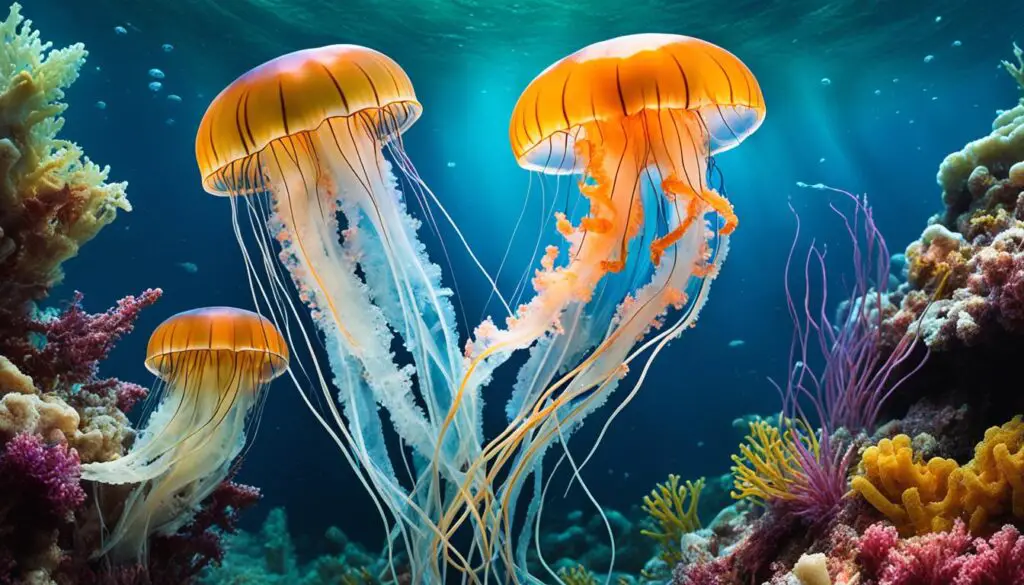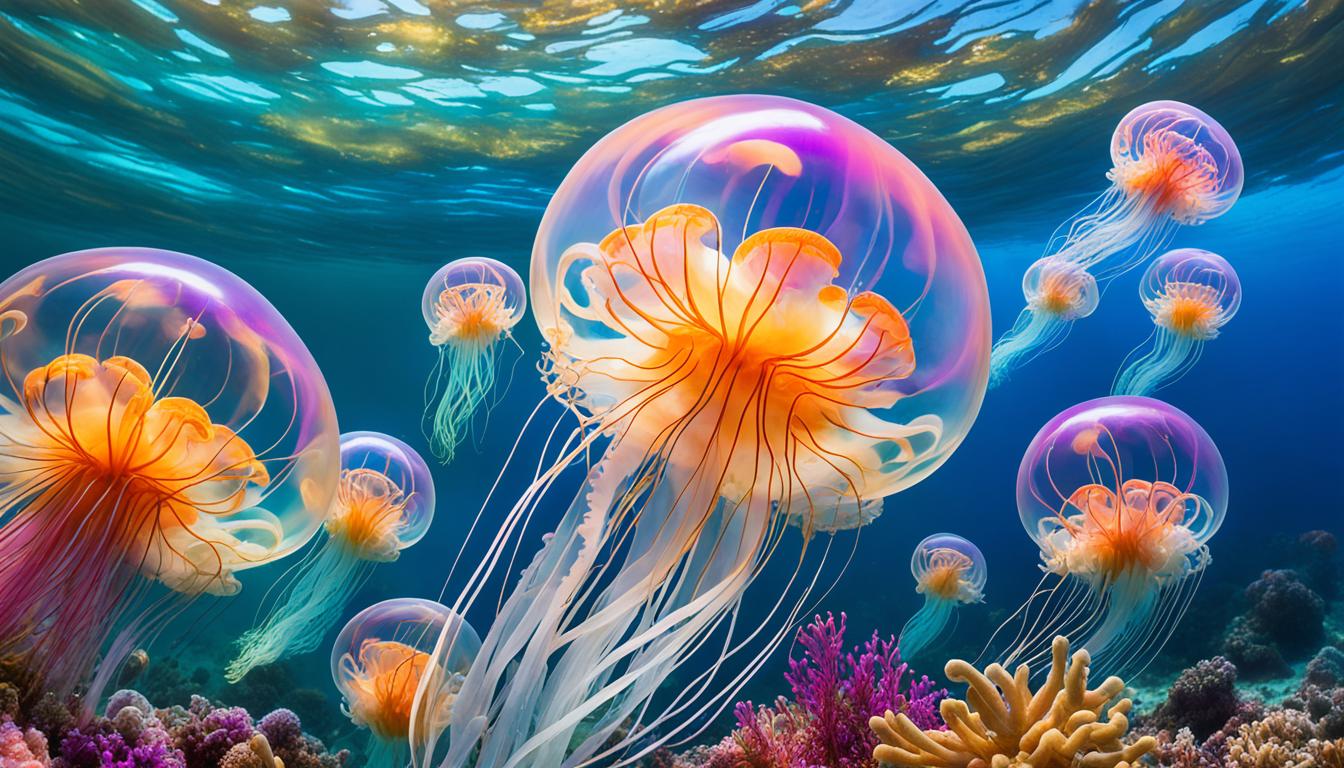Jellyfish are fascinating creatures that live in oceans all over the world. You might ask, where do jellyfish live? They are known for their gelatinous bodies and stinging tentacles. These beings have been around for over 600 million years, making them one of the oldest animal groups on Earth.
Exploring their home shows us diverse ecosystems where jellyfish live among other marine life. They have adapted to many environments, from shallow coastal areas to the deep ocean.
Understanding where jellyfish live helps us see their role in the ocean. As we learn more, we discover how they interact with other sea creatures. These relationships are key to their survival.
Understanding Jellyfish: An Overview
Jellyfish are fascinating creatures that belong to the subphylum Medusozoa within the phylum Cnidaria. They have a unique anatomy and life cycles that let them adapt to different environments. By studying jellyfish, we learn about their biology and the complex way they live.
What Are Jellyfish?
Jellyfish have beautiful, bell-shaped bodies filled with mostly water. This makes them well-suited for life in the ocean. They can have babies in two ways and change a lot as they grow. Jellyfish play a big role in the ocean’s ecosystem, working with many other living things.
Biological Classification of Jellyfish
Jellyfish are grouped into several main categories, each with its own special traits. The main groups are:
- Scyphozoa: These are the big jellyfish you often see.
- Cubozoa: Also known as box jellyfish, they have a box-shaped body.
- Hydrozoa: These small jellyfish go through two main stages in their life.
- Staurozoa: These are the jellyfish that stick to surfaces.
Knowing about these groups helps us understand how jellyfish adapt to their environments. It also shows us their role in the ocean’s ecosystem.
Where Do Jellyfish Live?
Jellyfish live in many places, showing how diverse and adaptable they are. They can be found in oceans and some freshwater areas. Their living places tell us a lot about how they survive.
Geographical Distribution of Jellyfish Worldwide
Jellyfish live in different places all over the world. You can find them near coasts and in shallow waters, where they join other sea creatures. They also live in the open ocean, where many species have found their perfect spot.
Some jellyfish even live in places where fresh and saltwater mix. This lets them survive in unique environments.
Survival Strategies in Diverse Habitats
Jellyfish are very good at adapting to different places. In warm waters, some jellyfish can control their buoyancy. This helps them stay at the right depth in the water.
They also form blooms to protect themselves from predators and to help them reproduce. This way, they can survive in changing conditions like temperature and salt levels.
Types of Jellyfish Habitats
Jellyfish live in many places that meet their needs. Each place they live affects how they survive, reproduce, and act. Knowing where jellyfish like to live helps us understand their role in the ocean.
Coastal Zones and Shallow Waters
Coastal areas are full of jellyfish because the water is rich in nutrients. Shallow places like estuaries and lagoons are perfect for many jellyfish. These areas have lots of food, which is key for their growth and making more jellyfish.
The mix of different sea creatures in these spots helps the jellyfish live well. It creates a balance between who eats who.
Open Ocean and Deep Sea Environments
The open ocean is a tough place for jellyfish. Yet, some species, like the lion’s mane jellyfish, can travel deep into the sea. They show how tough and flexible these creatures are.
The open ocean changes a lot because of currents and temperature. Jellyfish have to adapt to these changes to survive.
Freshwater Jellyfish Species
Some jellyfish live in fresh water, not just saltwater. These freshwater jellyfish live in lakes and rivers. They show how these creatures can live in different places.
Looking into these fresh water homes teaches us more about jellyfish. It shows how they can fit into many different environments.
Jellyfish Ecosystems: Interrelations in Nature
Jellyfish live in many marine places, playing key roles in the food chain. They show how different species are connected. As both hunters and hunted, jellyfish shape the balance in their homes.
Jellyfish as Predators and Prey
Jellyfish catch many sea creatures as predators. The biggest ones eat zooplankton and small fish with their stinging cells, called nematocysts. This helps them survive and grow.
At the same time, they are food for many sea animals, like:
- Sea turtles
- Certain fish species
- Some bird species
This double role makes jellyfish crucial to the ocean’s food web, helping many aquatic lives.
The Role of Jellyfish in Marine Food Chains
Jellyfish are key to keeping the ocean’s food chain balanced. They eat smaller creatures, controlling their numbers. Being eaten by bigger sea animals feeds them, creating a circle of life.
Changes in jellyfish numbers can greatly affect sea life and the health of the ocean.
Jellyfish Living Conditions and Adaptations
Jellyfish live in many different marine environments. They have special ways of surviving and thriving. These adaptations help them live in changing water conditions.
Physiological Adaptations to Marine Environments
Jellyfish have unique bodies that help them move and live in the water. Most of their body is made of a gel-like substance called mesoglea. This lets them control how buoyant they are.
This helps them move easily without using a lot of energy. They also have special body parts that change with the environment. For example, some jellyfish can change their size and shape with the temperature, salt levels, and food availability.
Behavioral Adaptations for Survival
Jellyfish change how they reproduce based on their surroundings. When there’s plenty of food, some species make more babies. This keeps their numbers strong when times are good.
They also hide from predators by looking like their surroundings. When they gather in large groups, they can be very hard to see. This helps them stay safe and shows how well they’ve adapted over time.
Notable Jellyfish Habitats Around the Globe
Exploring the world of jellyfish shows us unique ecosystems where they live. You might ask, where do jellyfish live and what makes certain places good for them? Each place has its own features that draw jellyfish, showing why we need to understand these habitats.
Examples of Rich Jellyfish Regions
Some areas are known for having lots of jellyfish. For example, the waters off Japan are home to the big Nomura’s jellyfish, which can be up to six feet wide. The Black Sea is also famous for its jellyfish blooms that happen every year and affect local fishing.
- Japan: Home to Nomura’s jellyfish
- Mediterranean Sea: Diverse species and large blooms
- Black Sea: Seasonal jellyfish influx affecting fisheries
Unique Features of Famous Jellyfish Locations
Jellyfish live in places with certain conditions that help them grow. Things like water temperature, salt levels, and food availability affect where they can be found. In the Mediterranean Sea, the warm waters and lots of food make it perfect for jellyfish, making it an important place to study.
| Location | Jellyfish Species | Key Characteristics |
|---|---|---|
| Japan | Nomura’s Jellyfish | Large sizes, abundant blooms |
| Mediterranean Sea | Various Species | Diverse ecosystem, nutrient-rich waters |
| Black Sea | Common Moon Jelly | Seasonal blooms, impacts on fishing |

The Impact of Environmental Changes on Jellyfish Habitats
Jellyfish habitats are facing big challenges due to human actions and natural events. Climate change is a big factor, making ocean temperatures warmer. This warmth can make jellyfish populations grow too big, upsetting the balance in their homes.
As more jellyfish appear, the ecosystem changes. This can harm the variety of species and change the food chain. It’s like a big puzzle where every piece is important, and jellyfish play a key role.
Pollution is another big worry for jellyfish. When pollutants get into the ocean, they can hurt jellyfish’s ability to reproduce and survive. This can lead to fewer jellyfish, making the ocean ecosystem less stable.
Urban growth makes things worse by changing the coastlines and taking away jellyfish habitats. It’s important to understand how these changes affect jellyfish to manage their numbers better. By seeing the value of jellyfish in the ocean, we can work to protect them and their homes.










